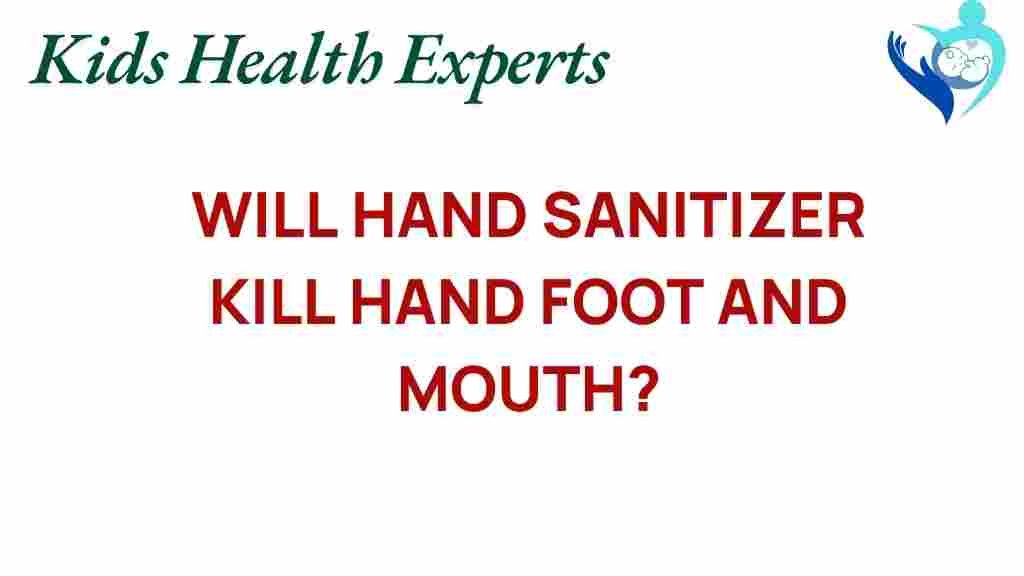Can Hand Sanitizer Effectively Combat Hand, Foot, and Mouth Disease?
Hand, foot, and mouth disease (HFMD) is a common viral infection that primarily affects young children, causing painful sores and rashes. As outbreaks of this disease occur in various communities, parents and caregivers are particularly concerned about infection prevention strategies. One of the most frequently discussed methods is the use of hand sanitizer. In this article, we will explore the effectiveness of hand sanitizer in combating hand, foot, and mouth disease while emphasizing the importance of good hygiene practices for children’s health and public health.
Understanding Hand, Foot, and Mouth Disease
Hand, foot, and mouth disease is caused by enteroviruses, most commonly the coxsackievirus. It spreads easily among children, especially in daycare and school settings. The symptoms often include:
- Fever
- Sore throat
- Painful sores in the mouth
- Rash on hands and feet
- Irritability in infants and toddlers
HFMD is usually mild, but it can lead to complications in some cases. Understanding how it spreads is crucial for effective infection prevention.
How Does HFMD Spread?
The virus responsible for hand, foot, and mouth disease can be transmitted through:
- Direct contact with an infected person’s bodily fluids, such as saliva or blister fluid
- Touching contaminated surfaces where the virus can survive for several hours
- Close contact, such as hugging or sharing utensils with an infected person
Because the virus is highly contagious, outbreaks can occur quickly, particularly in crowded environments like childcare centers. This emphasizes the role of hygiene practices in the prevention of disease transmission.
The Role of Hand Sanitizer in Infection Prevention
Hand sanitizer is a convenient tool for maintaining hand hygiene. However, its effectiveness against viruses like those causing hand, foot, and mouth disease can vary. Let’s break down the role of hand sanitizer in infection prevention:
Types of Hand Sanitizer
There are two main types of hand sanitizers:
- Alcohol-based sanitizers: These contain at least 60% alcohol and are effective against many germs, including some viruses.
- Non-alcohol-based sanitizers: These may not be as effective against viruses, including enteroviruses.
Effectiveness Against HFMD
While alcohol-based hand sanitizers can reduce the number of germs on hands, they may not eliminate all types of viruses, particularly non-enveloped viruses like the coxsackievirus responsible for HFMD. Therefore, while hand sanitizer is helpful, it should not be relied upon as the sole method of infection prevention.
Best Hygiene Practices for Preventing HFMD
To effectively combat hand, foot, and mouth disease, it is essential to implement comprehensive hygiene practices:
- Wash hands frequently: Use soap and water to wash hands for at least 20 seconds, especially after using the bathroom, changing diapers, and before meals.
- Use hand sanitizer: Apply alcohol-based hand sanitizer when soap and water are not available, but prefer handwashing whenever possible.
- Avoid close contact: Keep children away from those who are infected and avoid sharing personal items.
- Disinfect surfaces: Regularly clean and disinfect toys, countertops, and other surfaces that children frequently touch.
Step-by-Step Process for Effective Hand Hygiene
To maximize the effectiveness of hand hygiene in preventing hand, foot, and mouth disease, follow these steps:
- Wet your hands: Use clean running water (warm or cold).
- Apply soap: Lather the soap by rubbing hands together.
- Scrub all surfaces: Include the backs of hands, between fingers, and under nails.
- Rinse thoroughly: Rinse hands under clean running water.
- Dry hands: Use a clean towel or air dry them.
In situations where soap and water are unavailable, use hand sanitizer by applying a sufficient amount to cover all surfaces of the hands and rub them together until dry.
Troubleshooting Tips for Parents and Caregivers
While implementing hygiene practices, you may encounter some challenges. Here are some troubleshooting tips:
- Children resistant to handwashing: Make it a fun activity by singing a song or using a timer.
- Hand sanitizer irritates skin: Look for fragrance-free options or consider using moisturizing hand sanitizers.
- Outbreak in the community: Increase vigilance on hygiene practices and limit exposure to crowded places.
Public Health Implications
Hand, foot, and mouth disease is not just a concern for individual families but also for public health. Outbreaks can strain healthcare systems and disrupt community activities. By promoting effective hygiene practices, communities can work together to prevent the spread of this viral infection.
Health organizations emphasize the importance of education and resources for parents and caregivers to understand the symptoms of HFMD and the best practices for infection prevention. For more information on public health recommendations, visit the CDC’s website.
Conclusion
In summary, while hand sanitizer can play a role in infection prevention, it is not a foolproof solution against hand, foot, and mouth disease. Proper handwashing is the most effective method to reduce disease transmission. Parents and caregivers should prioritize hygiene practices to protect children’s health and contribute to public health efforts. By understanding the nature of HFMD and implementing comprehensive hygiene strategies, we can help minimize the impact of this disease in our communities.
For more resources on children’s health and hygiene practices, check out our hygiene guide.
This article is in the category Conditions and created by KidsHealthExperts Team

1 thought on “Can Hand Sanitizer Effectively Combat Hand, Foot, and Mouth Disease?”